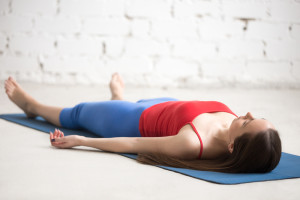Because the mind is so intrinsically linked with the breath,regulating the breathing pattern is one of the easiest and most natural ways to influence the mind.
This simple Brick Breathing exercise plays on the yogic practices of pranayama. It’s safe for beginners and can even be learned without a yoga teacher.
Brick Breathing soothes the mind, calms the nerves, and redevelops healthy breathing habits that prevent and relieve anxiety.
To understand the relationship of the mind and the breath, think of a time when you were very angry. How was your breathing affected?
You most likely started to breathing harder and more quickly. This is a common and natural human reaction.
Someone may have advised you to “take a deep breath” — which is actually great advice. In the case of anger, focusing on mindful breathing cools the system and checks the temper.
Anxiety and stress also affect the breath.
It’s common to tense the stomach and breathe shallowly into the chest during times of anxiousness.
This signals to the body that it’s under threat and triggers the sympathetic nervous system — the fight-or-flight mode. The body then slows down functions that aren’t vital at the moment so that it can focus on protecting itself.
This is all well and good if you’re actually in a life-threatening situation, but if not, you’re putting your body under unnecessary duress. Functions like digestion will suffer.
As you can see, it’s incredibly important to redevelop the ongoing habit of deep abdominal breathing for the health of the body and the state of mind.
Brick Breathing
If you’ve never practiced pranayama, brick breathing is a great place to start.
Here, you’ll lie down on your back and place a lightweight object on your belly. The goal is for the belly to move the object up and down by breathing fully and deeply.
When we’re stressed or anxious, we often clench our stomachs. Check in to see if you’re doing it now. Is your belly tight and your breath focused mainly in your upper lungs? This is a common (but bad!) habit.
The problem is that by contracting the abdominal muscles, we end up breathing shallowly into the chest. If we don’t exercise our lungs fully we deprive our internal organs of nourishing oxygen, as well as the gentle massage that the diaphragm brings to the organs.

Plus, shallow chest breathing can induce anxiety.
That’s right, breathing shallowly can cause anxiety. Conversely, anxiety causes shallow breathing. Our goal is to permanently undo this bad habit.
Practicing Brick Breathing for a few minutes each day is a great tool to do just that. Here’s how.
1. Prepare by finding a small object to place on your belly
Something like a paperback book is the perfect size and weight. Place it on the floor next to your mat.
2. Lie down on your back
Get comfortable, bringing your feet wide. Allow them to flop open. Rest your arms by your sides, palms facing the sky.
3. Relax
Take a few natural breaths through your nose to settle in
4. Inhale
Inhale through your nose, open your mouth, stick out your tongue and exhale while making an “ahhhhh” sound. This releases any tension in the jaw. Again return to natural breathing.
5. Notice if you’re clenching your belly
Consciously relax your abdominal muscles. It may take a few breaths to get there. With each breath you’ll be able to relax your belly a little bit further.
6. Now place the book or object over your belly
It should cover your belly button and the area just below it.

7. Breathe deeply
Take a long inhalation through your nose, filling the belly and chest with a nourishing breath. It can be slightly deeper and a little more dramatic than normal, but still breathe with a sense of effortless ease. The book or object should rise with your belly. This is deep abdominal breathing.
The diaphragm, a thin, dome-shaped muscle, is pushing downward on the abdomen, making the belly rise, and allowing the lungs to fill with air.
8. Take an easy, relaxed exhalation through your nose
The object should fall as your belly contracts. Here, the diaphragm is relaxing upward toward the chest. It pushes on the lungs to help expel air.
9. Continue breathing in this manner
Once you have the flow of breathing into the belly, close your eyes but maintain your focus on the belly rising and falling. You can practice this exercise for as long as you have time, whether it’s 3, 5 or 10 minutes.
10. Remove the object from your belly and return to natural breathing
Then roll onto your right side and support your head with your right hand. Rest here for a few moments. Slowly and mindfully push yourself up to sitting.
Quietly observe your state of mind and the calmness that this exercise brings.
After you get up and go about your day, check in every now and then to see what your belly is doing. If it’s tense and you’re breathing into your chest, spend a few breaths relaxing your abdominal muscles.
Practice Brick Breathing regularly to redevelop healthy breathing habits, or use it to soothe your mind whenever whenever you’re feeling overwhelmed, anxious, or stressed.

No comments:
Post a Comment